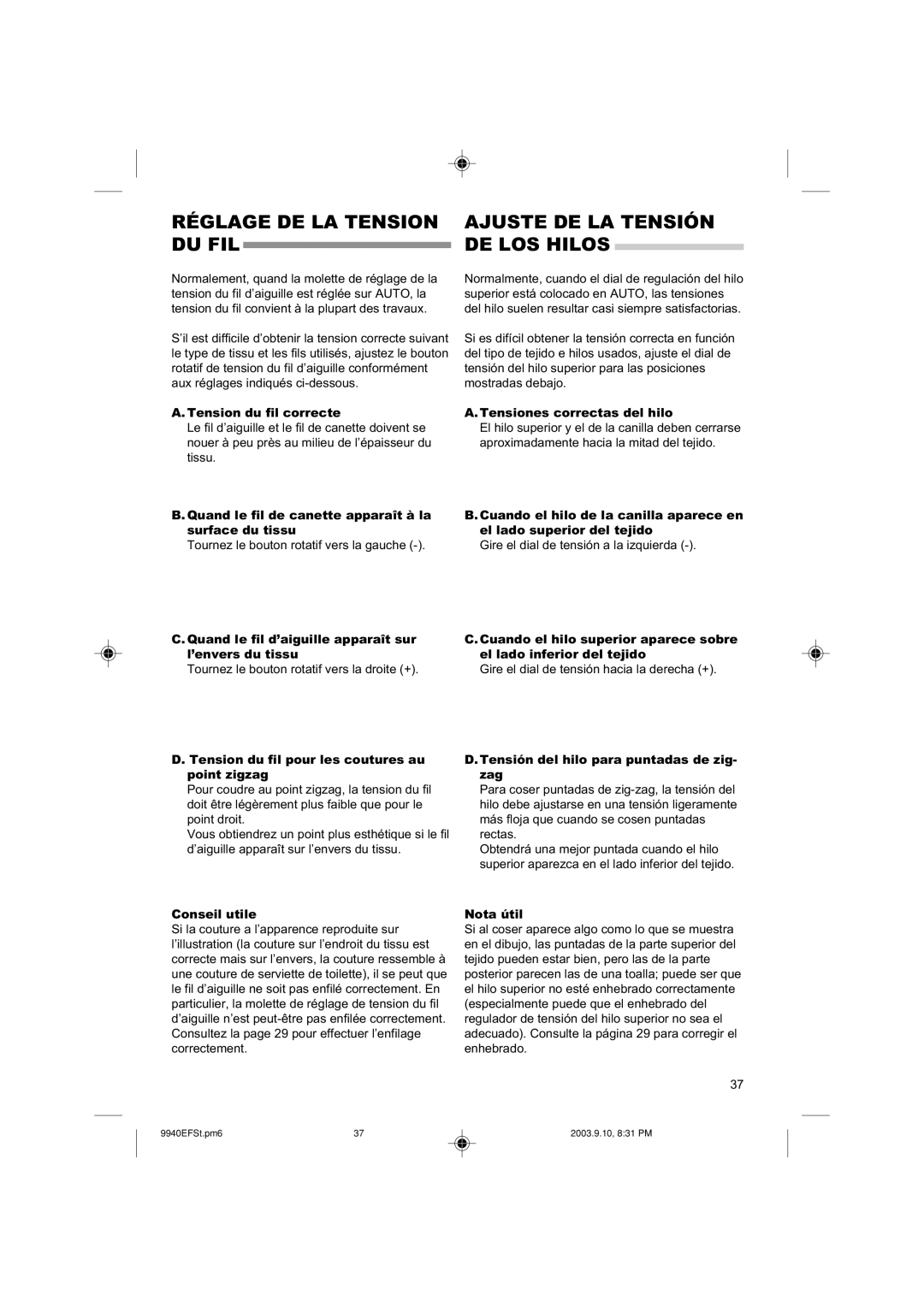9940
Important Safety Instructions
Contents
Consignes DE Sécurité Importantes
Écran D’AFFICHAGE
Table DES Matières
Manual DE Instrucciones
Precaución Para prevenir accidentes
Índice
Code. Blue neutral N Brown live L
For European and Similar Territories
Modèle
Bleu neutre N Marron phase L
Modelo
Azul neutral N, Marrón positivo L
Main Parts
Pièces Principales Partes Principales
Dust Cover
Accessories
Housse DE Protection Souple
Accessoiresaccesorios
Cubierta
Changing the Presser Foot
Extension Table
Changing the presser foot
Changement DE Pied Presseur
Plateau D’EXTENSION
Cómo Cambiar EL Prensatelas
FABRIC, Thread and Needle
Inserting the Needle
Type of Fabric Thread Size Needle Needle Size
Use a Singer brand needle for better sewing results
Tabla DE TEJIDOS, Hilos
Insercion DE LA Aguja
Agujas
Precaucion Para prevenir accidentes
Connecting Machine
Conexión DE LA Maquina
Branchement DE LA Machine
Peligro Para reducir el riesgo de descarga eléctrica
Function of Each Part
Función DE Cada UNA DE LAS Partes
Fonction DES Pièces ET Touches
Control Panel
Écran D’AFFICHAGE Panel DE Control
Setting Spool of Thread on Spool PIN
Bobbin Setting
Removing the Bobbin
Winding the Bobbin
Canette Ajuste DE LA Canilla
Inserting the Bobbin
Colocación DE LA Canilla
Mise EN Place DE LA Canette
Preparing to Thread Machine
Threading the Machine
Threading the Upper Thread
Enhebrado DE LA Máquina
Enfilage DE LA Machine
Drawing UP the Bobbin Thread
Threading the Needle EYE
Remonter LE FIL DE Canette
Enfilage DU FIL Dans LE Chas DE L’AIGUILLE
Enhebrado DEL OJO DE LA Aguja
Extracción DEL Hilo DE LA Canilla
Start and END of Seam
Starting to SEW
Upper Thread Sensor
Reverse Stitching
Début ET FIN DE LA Couture
Début DE LA Couture Comenzar a Coser
Marche Arrière
Principio Y Final DE UNA Costura
Sewing Heavy Fabric
Turning Corners
Seam Guide
Couture DE Tissus Épais
Couture DES Angles
Largeur DES Rabats
Cómo Girar EN LAS Esquinas
When upper thread appears on the bottom side of fabric
Adjusting the Thread Tensions
Helpful Hint
Quand le fil de canette apparaît à la surface du tissu
Tension du fil correcte
Quand le fil d’aiguille apparaît sur l’envers du tissu
Tension du fil pour les coutures au point zigzag
Selecting the Pattern
Selecting Utility Stitch Pattern
Réglage DE LA Largeur ET DE LA Longueur DU Point
Sélection DU Point
Selección DE LA Puntada
Ajuste DEL Ancho Y Largo DE LA Puntada
Mirror/reverse stitch
Twin needle setting
Elongation
Élongation
Points inversés / miroir
Ajuste de la aguja doble
Puntada invertida/reversible
Where to USE Each Stitch
Description DES Dónde Utilizar Cada Points Tipo DE Puntada
Straight Stitch
Straight Stitch Sewing
Straight Stitch With Auto-lock Stitch Pattern No
Puntada Recta
Couture AU Point Droit
Point droit
Puntada recta
Elastic Stitch Sewing
Basting
Hilvanado
FIL DE Bâti
Couture DE Points Élastiques
Puntada Elástica
Joining the pieces of fabric
Quilting
Quilting
Point de quilting, apparence fait main n7
Quiltingacolchado
Cómo unir las piezas de tejido
Puntada de acolchado con aspecto artesanal nº
MULTI-STITCH Zigzag
Zigzag Stitch Sewing
Free ARM Sewing
Elastic Band Sewing
Puntada DE ZIG-ZAG
Couture AU Point Zigzag
Point Zigzag Multiple
Puntada Múltiple DE ZIG-ZAG
Using the General Purpose Foot
Using the Overcasting Foot
Overcasting Overlocking
Sobrehilado Remallado
Surjet Surfilage
Blind HEM Stitching
Dobladillo DE Puntada Invisible
Couture D’OURLETS Invisibles
Patch Work
When sewing sharp angles
Applique
Labores DE Parcheado
Patchwork
Aplicaciones
Cuando cosa ángulos agudos
Cording
Narrow Hemming
Single Cording
Triple Cording
Dobladillos Arrollados
Ourlet Roulé
Cordonnets Cordoncillo
Inserting Zippers Centered Insertion
Inserción DE Cremalleras Inserción Centrada
Fermeture À Glissière Pose Bord À Bord
To Open the Zipper While Stitching
Inserting Zippers Lapped Insertion
Inserción DE Cremalleras Inserción Solapada
Fermeture À Glissière Pose Sous Patte
Ouvrir LA Fermeture À Glissière Pendant LA Couture
Buttonhole Sewing
Cómo Coser Ojales
Couture DE Boutonnières
Remarque
Nota
9940EFSt.pm6 2003.9.10, 832 PM
Nota
Automatic BAR-TACK Darning
9940EFSt.pm6 2003.9.10, 832 PM
Thread Shank
Sewing on Buttons
Bouton avec tige
Couture DE Boutons Cómo Coser Botones
Botones CON Talle
Continuous Decorative Pattern
Using the EVEN-FEED Foot
Sewing Thin Fabrics
Attaching the EVEN-FEED Foot
Couture
SUR LES Tissus Légers
Cómo Colocar EL Prensatelas DE Transporte Uniforme
Cómo Coser
Attaching the Darning Embroidery Foot
DARNING/FREE-HAND Embroidery
Darning
FREE-HAND Embroidery
Zurcido Y Bordado a Mano Libre
Reprisage / Broderie
Twin Needle Sewing
Cómo Coser CON Aguja Doble
Couture Avec Aiguille Jumelée
Decorative & Letter Stitch Sewing
To Change the Mode
Selecting Decorative & Letter Stitch
Puntadas Decorativas Y Letras
Couture DE Lettres ET Points Décoratifs
To Check Selected Patterns
Shifting the Cursor
Inserting Pattern
Vérification DES Motifs Sélectionnés
Déplacement DU Curseur
Insertion DE Motifs
Effacer UN Motif
Mirror / Reverse stitch
Setting of Each Pattern
Points inversés ou miroir
Réglage de la largeur et de la longueur du point
Ajuste DE Cada Diseño
Single / Repeat Sewing
Twin Needle Setting
Sewing the Selected Pattern
Tips
Couture DU Motif Sélectionné
Motif Répété / Motif Simple
Astuces
Ajuste DE LA Aguja Doble
Decorative and Letter Stitch Chart
9940EFSt.pm6 2003.9.10, 833 PM
Cleaning
Maintenance
Bobbin Holder
Hook Race and Feed Dog
Nettoyage
Entretienmantenimiento
Limpieza
Helpful Hints
Problem Cause Correction
Anomalie Cause Solution
Solution AUX Problèmes Courants
Recomendaciones Útiles
Problema Causa Corrección
9940EFSt.pm6 2003.9.10, 833 PM
9940EFSt.pm6 2003.9.10, 833 PM
9940EFSc.pm6 2003.9.10, 829 PM
9940EFSa 33094 C3

